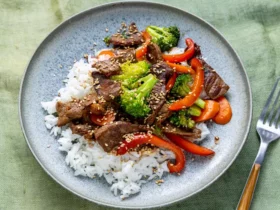Ingredients
Meat and Proteins
The foundation of any great chili recipe lies in its selection of ingredients, particularly when it comes to the meats and proteins that add depth, texture, and flavor to this beloved dish. When crafting a delicious and authentic chili, it’s essential to understand the various types of meat and protein that can be used, as well as their individual characteristics and uses.
Ground beef is one of the most popular choices for chili due to its rich flavor and ease of use. It provides a hearty, meaty taste without breaking the bank or requiring extensive cooking skills. However, other cuts like brisket, short ribs, and chuck are also commonly used in more advanced recipes, offering a richer, beefier flavor and tender texture.
Chorizo is a type of Spanish sausage that adds a spicy kick and a rich, smoky flavor to chili. It’s often used in combination with other meats or as the primary protein source for those seeking a bolder taste. Chorizo’s unique blend of spices and smoked paprika complements the other ingredients perfectly, elevating the dish to new heights.
Pork is another viable option when crafting your perfect chili recipe, particularly when opting for ground pork or diced pork shoulder. Its versatility allows it to be used in various quantities, ranging from a mild addition to an intense protein focus. The key advantage of using pork lies in its subtle yet distinct flavor profile that harmonizes well with other ingredients.
Chicken is not as common in chili recipes due to its leaner nature and lack of depth when compared to beef or pork. However, for those who prefer a lighter, healthier option or want to cater to specific dietary needs, boneless chicken breasts or thighs can be used successfully with proper seasoning and cooking techniques.
Variations in meat and protein can also include beans, which are an integral part of many chili recipes. Kidney beans, black beans, and pinto beans each bring their own unique texture and flavor profile to the dish. While they provide essential protein content, it’s worth noting that some people might perceive them as separate entities from traditional meats, making bean-based chilies a distinct option.
Ultimately, selecting the right ingredients for your chili recipe depends on personal taste preferences, cooking experience levels, and even specific dietary requirements or restrictions. By understanding the diverse characteristics of various meats and proteins, you can experiment and find the perfect blend to create your signature chili dish that’s as unique as it is delicious.
1 pound ground beef or ground turkey
- The foundation of a great chili recipe lies in the quality and choice of ingredients, with 1 pound ground beef being one of the primary components.
- In this case, we’re looking to use either ground beef or ground turkey, both of which will yield delicious results depending on your personal preference and dietary needs.
- Ground beef, in particular, is a staple choice for chili due to its rich flavor and hearty texture. It’s essential to choose a high-quality ground beef that’s at least 80% lean, as this will help prevent the formation of excess fat during cooking.
- The ground turkey, on the other hand, provides an excellent alternative for those looking to reduce their red meat intake while still maintaining a satisfying chili experience. It’s essential to choose a fresh and high-quality ground turkey that’s free of added preservatives or seasonings.
- Both options can be seasoned with a variety of spices and herbs to enhance their natural flavors, so feel free to experiment and find the perfect balance for your taste buds.
- Regardless of whether you choose ground beef or ground turkey, it’s essential to cook them thoroughly to ensure food safety and optimal flavor. Aim for an internal temperature of at least 160°F (71°C) and cook until the meat is browned and fully broken down.
1/2 cup chopped onion
- To make our delicious chili recipe, we’ll start by gathering the essential ingredients. One key component is the onion, and specifically, we need 1/2 cup of it.
- For this task, you should be able to chop one medium-sized onion into fine pieces. A rough estimate would put us at around 8-10 ounces or about 225-280 grams of chopped onion.
To help guide you through the chopping process, here’s a breakdown of the steps involved:
- Peel and trim the ends off one medium-sized onion.
- Cut the onion in half lengthwise, exposing its inner layers.
- Mince the onion into fine pieces using a sharp knife or a food processor.
The chopped onion is now ready to be added to your chili recipe. Remember that this ingredient will play a significant role in providing flavor and texture to your dish.
2 cloves garlic, minced
When it comes to adding flavor to our Chili Recipe, one crucial ingredient that plays a significant role is garlic. The recipe calls for 2 cloves of garlic to be minced.
Garlic has been used for centuries in various cuisines as a fundamental component of many recipes, including stews and sauces like our Chili Recipe. It adds an unmistakable aroma and depth of flavor that elevates the overall taste experience. For the 2 cloves called out in this recipe, we need to mince them.
Mincing the garlic breaks it down into tiny pieces which releases its natural oils, further contributing to a more intense aroma when cooked. This step is crucial as it allows the flavors of the garlic to mingle and blend with other ingredients in the recipe, including the protein, vegetables, spices, and sauces.
The next time you prepare your Chili Recipe, remember that mincing the 2 cloves of garlic is not just an afterthought; it’s an integral step that ensures a rich and full-bodied flavor profile. The slightly sweet taste and pungent aroma of the minced garlic complement the hearty beans, tender meats, or vegetables perfectly, making each spoonful a true delight.
In our Chili Recipe, the minced garlic acts as a base for other flavors to build upon. Whether it’s the smokiness of cumin, the heat from diced jalapeños, or the savory taste of diced onions and tomatoes, each component works together in harmony thanks to the subtle yet significant contribution of the 2 cloves of minced garlic.
In conclusion, while Chili Recipes often feature a medley of flavors, none is more fundamental than that of the minced garlic. Its unique ability to bring depth and warmth to our dish makes it an essential ingredient in our recipe, elevating the overall taste experience with each delicious bite.
1 tablespoon chili powder
When it comes to making a great chili recipe, the choice of ingredients can make all the difference. One key ingredient that adds depth and heat to the dish is chili powder.
In this context, one tablespoon of chili powder is a common amount used in many recipes. It’s worth noting that the type of chili powder you use can impact the flavor of your final product. Some popular options include:
- Mild chili powder: This variety adds a subtle, slightly sweet flavor to the dish.
- Medium-hot chili powder: This option provides a balanced blend of heat and flavor, suitable for most chili recipes.
- Hot chili powder: For those who like it spicy, this type of chili powder packs a punch and is best used in small amounts due to its intense flavor.
- It’s also worth considering the brand and quality of your chili powder. Some brands may add additional ingredients or use different grinding processes that can impact the final product.
- When using one tablespoon of chili powder, be sure to mix it well with other ingredients in the recipe to achieve an even flavor distribution. It’s also a good idea to taste the chili as you go and adjust the seasoning accordingly.
- Overall, one tablespoon of chili powder is a versatile ingredient that can add complexity and heat to your chili recipe. Experiment with different types and amounts to find the perfect balance for your taste buds.
Salt and pepper to taste
- In this chili recipe, we’ll be focusing on the essential ingredients that bring out the perfect flavor profile.
- The two key seasonings that add a burst of flavor to your chili are salt and pepper. These pantry staples are used to enhance the overall taste experience.
What is Salt?
Salt is a mineral composed primarily of sodium chloride, which gives it its characteristic flavor and preservative properties.
The primary function of salt in cooking is to bring out the natural flavors of other ingredients, as well as to add texture and depth to dishes.
Types of Salt
- Kosher Salt
- Table Salt
- Sea Salt
- Salt Crystals (Flake or Coarse)
Educating yourself on the differences between these types of salt is crucial to understanding their distinct uses in cooking.
What is Pepper?
Pepper, also known as peppercorns, are the dried berries of the Piper nigrum plant.
This versatile spice has been used for centuries as a natural preservative and flavor enhancer.
Types of Pepper
- Black Pepper
- White Pepper
- Green Pepper (also known as Tellicherry)
The addition of pepper in your chili recipe will not only add heat but also depth and a subtle complexity to the flavor profile.
Using Salt and Pepper to Taste
- When it comes to seasoning with salt and pepper, remember that these two ingredients should be added incrementally throughout the cooking process.
- Start by adding a small amount of salt and pepper at the beginning of the recipe, then taste and adjust as needed. This technique is crucial in achieving the perfect balance of flavors.
Key Tips
- Taste your chili regularly to ensure that the seasoning levels are balanced.
- Add salt and pepper incrementally, rather than all at once.
- Experiment with different types of salt and pepper to find the perfect combination for your taste buds.
Aromatics and Spices
The foundation of any great chili recipe lies in its ingredients, aromatics, and spices. When it comes to chili, the type and quantity of these components can greatly impact the overall flavor, texture, and authenticity of the dish.
Ingredients are the building blocks of your chili, providing the necessary protein, fat, and carbohydrates for sustenance. Common ingredients used in chili recipes include ground meat (beef, pork, or a combination of the two), beans (kidney beans, black beans, or pinto beans), tomatoes, onions, garlic, bell peppers, and potatoes.
Aromatics are the volatile compounds that contribute to the aromatic properties of your chili. Aromatics add depth, complexity, and a rich, savory flavor to the dish. Common aromatics used in chili recipes include onions, garlic, ginger, cumin, coriander, and chili peppers.
Spices, on the other hand, are the non-volatile compounds that contribute to the flavor and aroma of your chili. Spices add heat, depth, and a burst of flavor to the dish. Common spices used in chili recipes include cayenne pepper, paprika, chili powder, cumin, coriander, and oregano.
When selecting ingredients for your chili recipe, it’s essential to choose high-quality components that will complement each other and enhance the overall flavor of the dish. For instance, a good quality ground beef or pork will provide a rich, meaty flavor that pairs well with the sweetness of tomatoes and the spiciness of cayenne pepper.
Aromatics like onions and garlic should be sautéed until translucent to bring out their natural sweetness and depth of flavor. The aroma of sautéed onions and garlic will add a rich, savory flavor to your chili that is essential for an authentic taste experience.
Spices like cayenne pepper, paprika, and chili powder should be used in moderation to avoid overpowering the dish with heat or spice. A balanced blend of spices will add depth, complexity, and a burst of flavor to your chili without overwhelming the palate.
In conclusion, ingredients, aromatics, and spices are the key components that make up the essence of a great chili recipe. By selecting high-quality ingredients, using aromatics to enhance flavor, and balancing spices for heat and depth, you’ll be able to create an authentic, delicious, and mouth-watering chili dish that will satisfy even the most discerning palate.
1 teaspoon cumin
Cumin is a key spice used in many chili recipes to add depth and warmth to the dish. In this particular recipe, 1 teaspoon of cumin is called for, which may seem like a small amount but can make a significant impact on the flavor of the chili.
The type of cumin used in most grocery stores is typically ground cumin, which has been dried and then ground into a fine powder. This type of cumin is commonly used in Mexican and Southwestern-style cooking and works well in chili recipes that call for a bold, earthy flavor.
Ground cumin is available at most grocery stores and can usually be found in the spice section. It’s often packaged in small jars or containers to preserve its flavor and aroma. When shopping for ground cumin, look for a brand that has been certified as organic or fair-trade to support sustainable agriculture practices.
To use 1 teaspoon of ground cumin in this recipe, simply measure out the correct amount using a measuring spoon or a digital scale. You can also use a spice grinder or mortar and pestle to freshly grind whole cumin seeds if you prefer a more intense flavor and aroma.
Once you’ve added the 1 teaspoon of ground cumin to the pot, stir it in well with the other ingredients and let it cook for a few minutes to allow the flavors to meld together. You can also toast the cumin in a dry pan over low heat for a minute or two before adding it to the chili to bring out its natural oils and deepen its flavor.
1 teaspoon paprika
- Paprika is a spice made from ground dried sweet peppers, which are a type of bell pepper. It is a key ingredient in many cuisines, particularly in chili recipes, as it adds depth and warmth to dishes without adding heat.
- The mild variety of paprika, such as the one called for in this recipe (1 teaspoon), has a sweet, earthy flavor that complements the other ingredients in a chili. It is often used to add color and flavor to stews, soups, and braises.
- In terms of its chemical composition, paprika contains a number of compounds that contribute to its flavor and aroma, including carotenoids (which give it its red color) and capsaicin (although in much smaller amounts than in hot peppers).
- The use of paprika as a spice dates back thousands of years to the ancient Romans, who used it to season their food. It has since become a staple ingredient in many cuisines around the world, including Hungarian, Spanish, and American.
- In chili recipes like the one described here, paprika serves several purposes. It adds flavor and depth to the dish, which is especially important when using ground beef or other meats that can be relatively bland on their own. Additionally, it provides a subtle smokiness that complements the other ingredients, such as tomatoes, onions, and garlic.
- It’s worth noting that there are different types of paprika available, including sweet paprika, smoked paprika, and hot paprika. The sweet variety is typically used in chili recipes like this one, as it adds a mild, earthy flavor without any heat or bitterness.
1/4 teaspoon cayenne pepper (optional)
- Cayenne pepper is a type of chili powder that adds heat to dishes.
- In the context of this chili recipe, the 1/4 teaspoon of cayenne pepper serves as an optional ingredient for those who prefer their chili with some level of spiciness or for adding depth and warmth without overpowering other flavors.
- Cayenne peppers are a variety of hot peppers that come from Capsicum annuum.
- They have a bright red, thin, and hollow pod shape, with a pointed end at the top and usually having four small lobes on its sides.
- The heat in cayenne peppers is produced by chemical compounds called capsaicinoids, with capsaicin being the primary component responsible for their burning sensation when consumed.
- Capsaicin stimulates the pain receptors in the tongue and mouth, creating a sensation of heat or burning that people often describe as spicy.
- The use of cayenne pepper in this chili recipe highlights its role in balancing flavors and adding warmth without overpowering other ingredients.
- It is an optional ingredient, which means individuals can choose to omit it if they prefer their chili less spicy or do not tolerate capsaicin well.
- In terms of nutrition, cayenne peppers are low in calories and rich in vitamins A and C, potassium, and fiber.
- They contain antioxidants and anti-inflammatory compounds that have been linked to several health benefits, including reducing inflammation and improving cardiovascular health.
Precautions when handling cayenne pepper:
- Wear gloves or rub your hands with lemon juice after handling hot peppers like cayenne pepper to avoid transferring the oils to your eyes or other sensitive areas.
- Avoid touching your face or eyes while preparing dishes containing cayenne pepper, as the oils can cause irritation and discomfort.
- If you experience any discomfort, burning sensation, or pain in your mouth, throat, or digestive tract after consuming cayenne
- pepper, discontinue use immediately.
Tips for using cayenne pepper:
- Use it sparingly to avoid overpowering other flavors in the dish.
- Start with a small amount and adjust to taste.
- Consider pairing cayenne pepper with acidic ingredients like tomatoes or citrus juice to balance its heat.
- Be cautious when handling hot peppers, especially if you are sensitive to capsaicin.
Chili Base
A chili base, also known as a chili paste or chutney, is a fundamental ingredient in many chili recipes. It adds depth and richness to the dish, providing a concentrated flavor profile that enhances the overall taste experience.
Typically, a high-quality chili base should contain a blend of spices and aromatics that have been cooked together for an extended period to develop their flavors. This can include ingredients like onions, garlic, ginger, cumin seeds, coriander seeds, cinnamon sticks, cardamom pods, and red chilies or other types of hot peppers.
The proportions of these ingredients can vary depending on the specific type of chili base being made. Some recipes may call for a stronger emphasis on spices like cumin and coriander, while others might focus more on the heat provided by hot peppers.
A well-balanced chili base should also have a good balance of acidity and sweetness to counteract its spiciness. This can be achieved through the addition of ingredients like tomatoes, vinegar, or sugar.
The texture of a chili base is typically smooth and thick, but it can range from a coarse paste to a more refined chutney-like consistency depending on how it’s processed. Some recipes might involve grinding the ingredients into a fine paste using a spice grinder or blender, while others may be left coarser for added texture.
When choosing a store-bought chili base, look for products that are labeled as “all-natural” or “homemade-style,” as these tend to contain fewer preservatives and additives. You can also find chili bases in various forms like paste, powder, or flakes, so it’s worth experimenting with different textures and flavors to find what suits your taste preferences.
Homemaking a chili base from scratch allows you to tailor the flavor profile to your liking and avoid any preservatives or additives found in commercial products. You can also store homemade chili bases for longer periods in the fridge or freezer, making it an excellent option for meal prepping and batch cooking.
Overall, a great chili base is essential for creating authentic and delicious chili recipes that satisfy both your taste buds and your senses.
Canned Tomatoes and Beans
When it comes to making a delicious chili recipe, the quality and selection of ingredients play a crucial role in determining its flavor, texture, and overall success. One essential component that is often overlooked or underestimated is canned tomatoes and beans.
Canned tomatoes are a staple ingredient in many chili recipes due to their convenience, affordability, and versatility. They come in various forms, including crushed, diced, and chopped, which cater to different cooking needs and desired textures. Crushed tomatoes, for instance, are ideal for adding depth of flavor to the dish without introducing any texture changes.
Canned beans, on the other hand, offer a convenient way to add protein, fiber, and moisture to the chili without the hassle of soaking and cooking dried beans from scratch. Popular types of canned beans used in chili recipes include kidney beans, black beans, pinto beans, and cannellini beans.
The choice of canned tomatoes and beans ultimately depends on personal preference and the type of chili being made. Some people prefer to use a combination of both, while others opt for one over the other. For example, a vegetarian chili might rely heavily on canned beans for protein, whereas a meat-based chili may use more canned tomatoes for added depth.
When selecting canned tomatoes and beans, it’s essential to check the ingredients list for any additives or preservatives that may impact the flavor of the dish. Some brands may contain high amounts of sodium or artificial flavor enhancers, which can compromise the overall quality of the chili.
Opting for low-sodium or no-salt-added canned tomatoes and beans is a great way to control the salt content of the dish without sacrificing flavor. This is particularly important for those with dietary restrictions or preferences.
Another consideration when choosing canned tomatoes and beans is their BPA-free status. Some cans may contain BPA, a chemical that has been linked to health concerns. Choosing BPA-free options ensures that consumers are not exposed to potential toxins during the cooking process.
In terms of storage and handling, canned tomatoes and beans require minimal care and can be stored for extended periods without refrigeration. Simply check the expiration dates and store them in a cool, dry place to maintain their quality and shelf life.
2 cups chopped fresh tomatoes or 1 can diced tomatoes
- The first ingredient listed for this chili recipe is the foundation upon which the flavors and textures are built. 2 cups chopped fresh tomatoes or 1 can diced tomatoes provides a crucial starting point.
- Fresh tomatoes offer a level of depth and richness that can’t be replicated by canned alternatives. When using fresh tomatoes, it’s essential to select ripe, flavorful varieties like Roma or Heirloom for the best results.
- For those who prefer or don’t have access to fresh tomatoes, canned diced tomatoes are an excellent substitute. Look for low-sodium options to avoid adding unnecessary salt to your dish.
- In either case, be sure to remove any seeds or excess moisture from the chopped tomatoes to prevent a watery consistency in your chili. This step may seem minor, but it makes a significant difference in the overall texture and flavor of the final product.
- When working with canned diced tomatoes, you can simply pour them directly into your pot without worrying about seed removal. However, keep an eye on the liquid levels and adjust as needed to achieve the desired consistency.
- The 2-cup measurement is a general guideline and may vary depending on personal preference or specific recipe requirements. Feel free to adjust the quantity based on your taste buds and the other ingredients in your chili.
1 cup kidney beans, black beans or pinto beans
Kidney beans, black beans, and pinto beans are all popular choices for adding protein and fiber to a hearty chili recipe.
Kidney beans are a type of white bean that has been shelled from its pods, giving them their distinctive kidney shape and color. They have a mild flavor and a tender texture that works well in chili recipes.
Black beans, on the other hand, are small, dark-colored beans with a slightly sweet and nutty flavor. They’re a staple ingredient in Latin American cuisine and pair particularly well with bold spices and tomato-based sauces like those found in chili.
Pinto beans, also known as “frijoles pinton” in Spanish, have a distinctive speckled or mottled appearance due to their grayish-white color with brown streaks. They’re mild in flavor and soft in texture, making them an excellent choice for soups and stews like chili.
When substituting one type of bean for another in a chili recipe, keep the following in mind: kidney beans will break down quickly and become tender during cooking; black beans hold their shape well but may retain some firmness even after long cooking times; pinto beans tend to stay soft throughout the cooking process.
In general, all three types of beans can be used interchangeably in a chili recipe, although the flavor profile may vary slightly depending on personal preference or regional traditions. Feel free to experiment with each variety and find your favorite combination for creating the ultimate chili experience!
- Best Clay Alternatives for 2025 - April 22, 2025
- Best Leadfeeder Alternatives for 2025 - April 22, 2025
- Best Snov.io Alternatives for 2025 - April 21, 2025















